Thanks for joining me!
Good company in a journey makes the way seem shorter. — Izaak Walton

Thanks for joining me!
Good company in a journey makes the way seem shorter. — Izaak Walton

It’s summer vacation, so we have not posted as much….
OK, true: the whole year has been like the best summer vacation of my life.
But still, it’s been a more relaxed pace in the last two months for us, in part because we’ve had to take care of van-related business in Holland and the UK, and in part because we’re trying to savor the passage of time. So our camper van is now Dutch and British Inspected, and is slumbering in a great secure storage place in East Anglia.
And we got to be part of our son Carter’s official wedding to Jennifer, courtesy of our dear friend Bishop Mariann Budde and 70 guests at a wonderful ceremony last weekend in London. Highlights included an awesome dinner our whole family prepared and served in our air bnb, a day of games on Hampstead Heath, a visit to the pub where Carter and Jen met three-plus years ago, and so much singing and laughing. Special thanks to our hosts Laura and Mike and Peter and Sue, Jennifer’s parents and step-parents. And her siblings, Toby Coe and Lucy Noel. If our son has to live so far away, well, at least he’s part of a tremendous family now.
June was spent mostly in the former Yugoslavia, then Germany, and July was Van Month in Utrecht, Wales, and England.
Thanks for the birthday wishes. We’re in the last few months of this once-in-a-life-time-year-long traveling sabbatical trip. John had to return to the U.S. for a funeral. So I’m spending my 60th birthday on my own in a campground in Munich, Germany, yet thanks to email, Facebook, Twitter and WhatsApp, I’m feeling lots of love and don’t feel lonely.
I’m sitting in the shade at our camp site, listening to the birds sing, with a cold beer in the cooler and a good wifi connection. I continue to be amazed that we can live this well and comfortably for the princely sum of between $20–$30 a night.
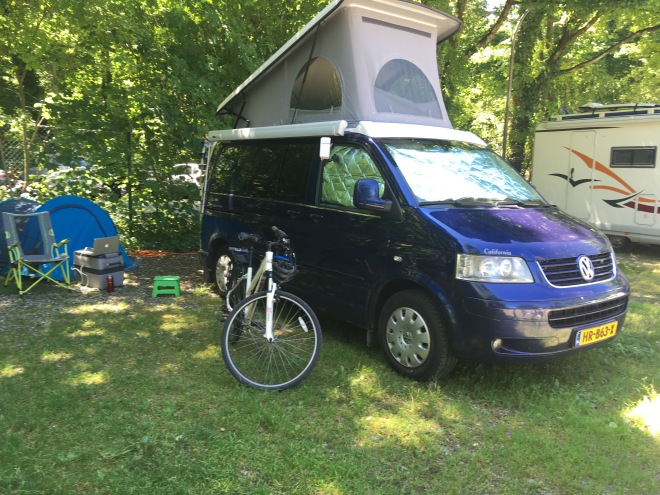
This is our 4th trip camping in Europe. Camping is how lots of people travel here, so campgrounds are everywhere and they’re more like outdoor hotels than roughing it. Campgrounds come with clean bathhouses, hot showers; big communal sinks where you can wash dishes; a little café, bar or market where you can buy fresh bread and croissants. (But no picnic tables, so you have to bring your own tables and chairs. It’s a little weird, given that European campgrounds seem to have everything else.)\
Campgrounds are often located in cities too. So if you have three or more weeks to travel and can rent a vehicle, camping is such a relaxing and affordable able way to move around Europe. On our first three trips, we brought our tent and gear from home and rented a regular van (when we were traveling with three kids) and just a regular Toyota Corolla type car when it was just John and myself.
It worked great. Yes, we looked like a minor-league hockey team dragging duffles of gear through the airports. But once we loaded them all in our rental car at the airport, we were set to go.]
But on this last trip, we bought a camper van because we were going to be gone for a year and camping in cold weather. It was no small investment, but it’s worked out so well, we’ve decided to keep it, store it outside of London and use it on future trips, especially since our son, Carter, now lives in London with his wife. Retirement is still some years off, but at age 60, it beckons!\
At any rate, some people have a cabin on the lake. We will now have a camper van on the other side of the Atlantic.
Our van has a bike rack and we bought two bicycles. So we usually park the van in the campground and then use our bikes to get around. This has been especially great in Munich, which is like the Minneapolis of Europe in that it’s relatively flat; there’s a huge system of designated bike paths; the beautiful, clean, fast-running Isar River runs through the heart of the city and there’s theaters, concerts, parks and really great beer everywhere you look.
I mean, it’s a just a flat-out fantastic place. If you haven’t been to Munich yet, come! Here’s the cute campground restaurant overlooking the river. #LivingLarge.

Munich was also the birthplace and the central headquarters of the Nazi party. A couple of days ago, I visited one of the city’s newest museums, the Munich Documentation Centre for the History of National Socialism. Yeah I know. Maybe it sounds better in the original German. Anyhow, it’s a long, ponderous name for a courageous, thoughtful place that was built on the very site of the first Nazi party headquarters.
“Again and again, a democratic society faces challenges that demand we take a stand and show moral courage, “ says the centre’s guide in its opening sentence. “Right-wing radicalism, anti-Semitism, Islamophobia, and racism call for a clear ‘no’ from a vast and often-silent majority”
As an American living in the Age of Trump, this immediately got my attention.
”….Munich was tied to and entangled with National Socialism more than any other city,” the guide goes on, noting that the Dachau concentration camp–the first model of Nazi terror and its ‘school of violence’—was organized out of Munich in 1933; the 1938 “Munich Agreement” annexing Czechoslovakia was signed here; the terrible ‘Kristallnacht’ pogrom was first announced from Munich’s city hall on November 9th 1938.
“Munich citizens as well as Munich authorities bore a decisive share of responsibility for the emergence and spread of radical, right-wing ideology.” reads the guide. So in addition to commemorating what happened here, the question the center asks is, why of all places was Munich the fertile ground for the Nazis ideology and program? What were the social forces, mindsets and habits that allowed so many people to either actively embrace such hatred or pretend it wasn’t happening?
This is really a gutsy question because most common responses from a people or culture that commit an atrocity is to first deny it happened; then to minimize it; and then maybe, after a long time, to build a memorial to the victims, which can promote empathy with victims while also strangely letting the perpetrators off the hook.
I mean, can you imagine the citizens of South Carolina or Texas or Minnesota or really anywhere in the U.S. building a center that studied how its people or culture bore a decisive share of responsibility for the spread of ideology and beliefs (especially right-wing beliefs) that ended in human rights abuses….like, say, police being able to kill black people with no consequences? Or police never really investigating black-on-black murders in places like Baltimore or Chicago? Will there ever be a Chicago Documentation Center Center For The Study of Ghettoside? Or mass imprisonment? Or Jim Crow? Or the destruction of native people?
No, because that would strike pretty close to home…i.e. to the people who still hold the power, which is why most cities wouldn’t touch that kind of subject with a ten-foot pole.
So hats off to Munich for being willing to go there and especially the group of citizens who spent 25 long years trying to get this center built. It’s a fascinating exhibit. If you’re in Munich, go see this place.
I found the parallels to what happened in Munich and what’s happening in Trump’s America to be disturbing: how right-wing violence was tolerated and ignored; (because it wasn’t seen as scary as left-wing violence); how the courts system contributed to this with its leniency towards Nazism, especially during its key early days before Hitler seized power; how some extremely wealthy people financially quietly underwrote Hitler; how mainstream German conservatives felt they could work with Hitler to achieve shared goals and somehow control his worst tendencies and finally how Hitler used propaganda so effectively to frame his narrative and to tap into bigotry and nationalism.
No, I don’t think we’re on the immediate verge of the Third Reich in America. But damn, there ARE disquieting parallels.
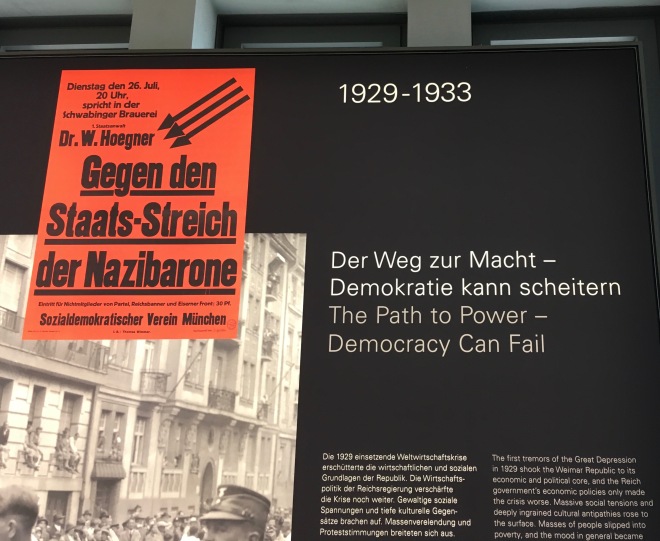
So one one side, Munich is a cautionary tale about what happens when democracy fails, which it did in Munich and Germany in the 1930s. And on the other side, today, Munich is an inspiring tale on how a society can rebuild and remake itself in really healthy ways after the unimaginable happens.
One thing that’s clear after this year of travel is that life is so full of paradox. People are awful. People are wonderful. Horrible, horrible shit happens. So does resurrection.
One last thing…I say this on every birthday, but it’s true. On June 26th, 1983, on my Golden Birthday, i.e. on the day I turned 26 years old—I met my wonderful husband, John Bellaimey. Thirty-four years later, he is still the gift who keeps on giving and the best present ever. Here he is, after landing in his hometown of Detroit two days ago:

Thanks for all the birthday wishes! We’ll be back in Minneapolis in mid-August. Love to all of you!!!!
 Even though he probably didn’t say exactly that, Luther’s most famous quotation is now available on these attractive ankle socks, in case you want to celebrate the 500th Anniversary of his nailing the 95 Theses on the church door in Wittenberg. .
Even though he probably didn’t say exactly that, Luther’s most famous quotation is now available on these attractive ankle socks, in case you want to celebrate the 500th Anniversary of his nailing the 95 Theses on the church door in Wittenberg. .
500 years ago on Hallowe’en Day, The Rev. Dr. Professor Martin Luther took a hammer and several sheets of heavy paper with him to the Castle Church in his adopted hometown. Wittenberg is in the former East Germany, south of Berlin. He was already a well-known professor of Biblical interpretation, a monk who confessed his sins every day, and an admirer of the young scholars who called themselves humanists.
 The paper, of course, had the famous sentences on them, in Latin, meant to stimulate discussion among his students, fellow faculty, and the other literate people in town, including the Elector, who was a sort of governor of the region. The first thesis said that since Jesus urged people to repent, he meant for all of us to keep doing it. After all, we didn’t stop taking the wrong path just because our parents had us baptized. Don’t go with the flow, he urged: fight against it!
The paper, of course, had the famous sentences on them, in Latin, meant to stimulate discussion among his students, fellow faculty, and the other literate people in town, including the Elector, who was a sort of governor of the region. The first thesis said that since Jesus urged people to repent, he meant for all of us to keep doing it. After all, we didn’t stop taking the wrong path just because our parents had us baptized. Don’t go with the flow, he urged: fight against it!
He chose All Hallows’ Day (All Saints Day, we call it now), the one day of the year when the Elector let everyone into what was essentially a private church for the nobility and church hierarchy.
The scandal had recently leaked out that the local Bishop, who’d been selling indulgences like they were initial public shares of Apple or Google, was not actually sending the money to Rome as advertised, but keeping it. And paying Rome with a secret high-interest loan.
The idea of indulgences was bad enough, Luther and his colleagues said. Very few people bother to go to confession any more. They don’t think about their inner lives, their ethics, their goals. They just buy one of these lovely documents, say the prescribed penitential words, and poof! Guaranteed removal of sins. St. Peter will put you in the Platinum Lane at the Pearly Gates. A plenary indulgence was a ticket to heaven.
But surely the God Jesus described in the New Testament would not approve of this. Surely Jesus, who raged against the money-changers in the Temple, would tell these traveling indulgence salesmen to hit the road, after tearing up their inventory.

That was 1517. 500 years ago this coming Halloween. By 1521, under pressure from the church hierarchy, the young Emperor Charles V ordered Luther to Worms, where the Reichstag (sort of a Parliament) met. He was told to recant. He refused, and was declared a heretic and outlaw. Outlaws could not be fed, housed, or defended against violence. By this time, the theses had been copied and read all over the German-speaking lands. Luther’s protector, the Elector of Saxony, arranged to have him “kidnapped” and “imprisoned” in a rather comfortable room in Wartburg Castle, about an hour’s drive from here. In eleven hyperactive weeks while there, Martin translated the New Testament from the original Greek text into good, memorable, down-to-earth German. His work was so good that, maybe even more than Shakespeare’s English, he single-handedly created a common German vocabulary and way of writing. Hundreds of his phrases are now in everyday use. Luther was a brilliant scholar, but he knew how to speak to ordinary people.
When he left his exile and came back to Wittenberg, he was a local hero. Along with his fellow-professor Philipp Melanchthon and many others, he developed a Reformed Christian creed:
Spirituality, not empty rituals or fake documents
Bible reading, not ignorant obedience
Individuality, not hierarchy
Democracy, not feudal oppression
Johann Gutenberg’s industrial genius made mass-printing of books popular, and Die Bibel would become the best-seller of all. But for the majority of Germans who were unschooled there was also art. The pamphlet below contrasts Christ, who washed his disciples’ feet, with the Anti-Christ, the Pope, whose supplicants kissed his feet. You didn’t need literacy to understand the pictures.

Up the river a half-mile from the Castle Church is the City Church, where Luther preached 2000 times or more. As a Protestant church, it’s plainer than Catholic churches, but still beautiful and full of images of God’s strength and mercy. I especially liked this inscription of Thesis #62: “The true treasure of the Church is the Most Holy Gospel of the glory and the grace of God.” Not like all that marble, gold, and silver “treasure.” Sorry it’s so small. And in German.

Here’s a strongbox used for collecting payments for indulgences, with three different locks. I wonder if the salesman had any of the keys.

The monastery in Wittenberg was soon closed as was the convent of nuns. Many of the former religious married one another, as did Martin and Katharina von Bora. The Elector made sure the Luthers had an income, and housing. In fact, the former monastery was turned over to their family, and sometimes Katharina fed 60 people per day, including their six children and eleven adoptees, plus refugees, visitors, and wayfaring strangers. Preach the Gospel, St. Francis once wrote, if necessary, use words.

Melanchthon got a comfortable house down the street, too, and housed students in the garret rooms I visited on the third floor. His table was also famous. Known since boyhood as a genius for his amazing skill with ancient and modern languages, he helped his older colleague Luther with countless passages in Greek and especially Hebrew. Luther spent more than a decade on the Old Testament
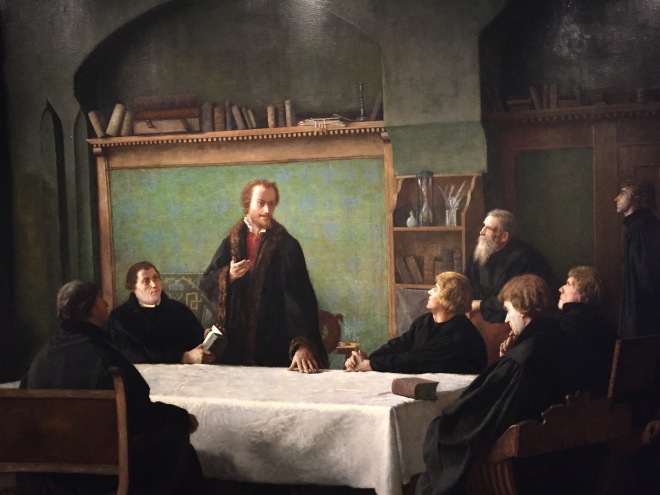
German rulers in their patchwork of states, counties, duchies, and so on had to choose up sides. Protestantism tended to do best in the north, and Catholicism in the south, but there were exceptions. German Bible sales in Catholic jurisdictions were forbidden and brisk.
As a language nerd, I feel closer to Melanchthon than to Luther. He was more inclined to smooth conflicts over (like me). When the younger Melanchthon finished his masterpiece summary of the Christian faith, Luther marveled at its diplomacy. He said, “I do not think I could have managed to tread so lightly.” Perhaps Melanchthon lacked the courage of the fiery Luther.
Or perhaps he believed you could catch more flies with honey than vinegar. My seminary professor at Harvard, Margaret Miles, used to encourage us to use the “hermeneutic of generosity” rather than the “hermeneutic of suspicion.” Temperamentally, I lean towards the generous rather than suspicious, but I sure do admire Luther. Here’s the table where Melanchthon used to lead tutorials:
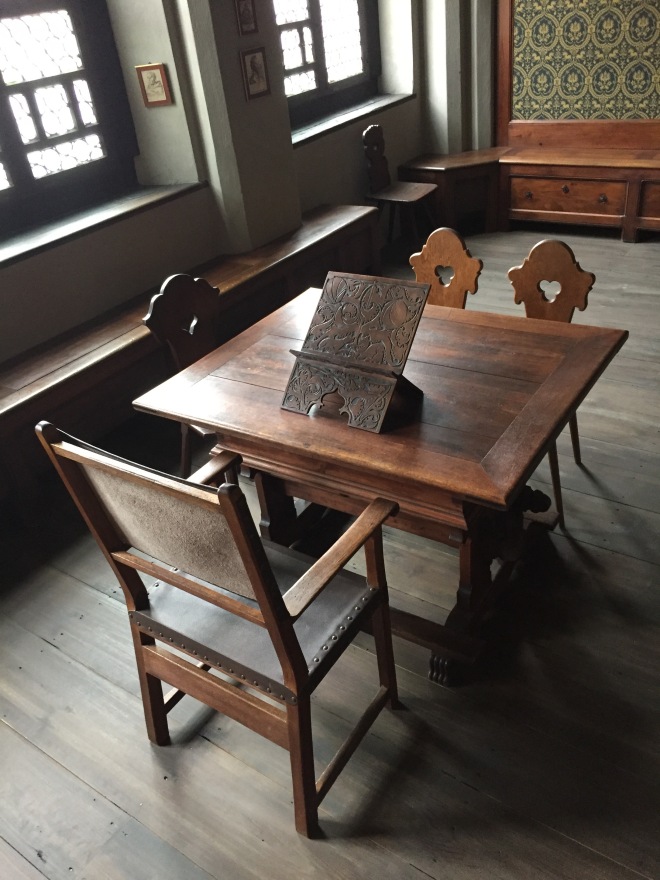
And here is Luther’s famous Table Talk table, where students and colleagues would strive to remember every quotable story, polemic, tirade, crude analogy, and sincere confession, so they could write it down afterward.

Lynnell and I came to Wittenberg to learn more about the man who split Christianity. It’s often said that he did not intend to found a new branch of the Christian tree, but that’s what happened. He didn’t want to be The Great Divider. But the situation seemed to offer him no choice. Protestants went from being a party of reform to what we’d now call a “denomination.” Compared to Calvin and Zwingli’s mobs, Luther would say, we’re mild and reasonable.
Indeed, Lutheran and Catholic churches, to the untrained eye, are not very different at all, especially the contemporary ones. Especially since the 1960’s, when the Catholic Church agreed that worship should be in the local language, and the Bible should be widely-read and studied by all. There’s still a split over married clergy and the sacraments (Lutherans celebrate 2 and Catholics 7), but there is more river than tree these days between the former enemies.
I had to smile as I watched three women cart their day-care toddlers down the main street of Wittenberg, where Luther and Melanchthon and their families used to walk to the market and to church.
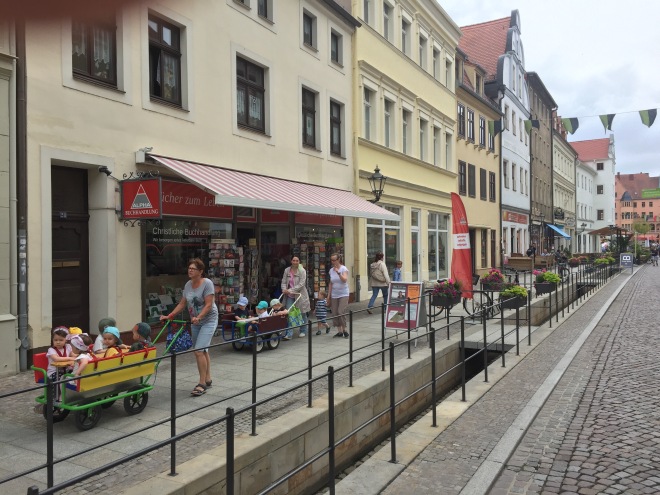
I visited a park with modern art installations celebrating this 500th Luther Anniversary. One was a mirrored cross you walked under so you could see what you look like from above. I was reminded of the Prince of Egypt song, “Look at your life with heaven’s eyes.”

I close with this deft summary of Martin Luther’s understanding of Jesus:

It’s a good reminder for all of us peacemongers and diplomats who think we just need more understanding and cooperation: although Jesus surely stood for that, his very life, death, and resurrection were meant as a rebuke to worldly power.
Blagej was, once upon a time, the capital of Bosnian royalty. It’s a small, quiet town at the spot where a very short river (the Buna)  meets a bigger one. (Map: bottom right)
meets a bigger one. (Map: bottom right)
Mostar became the capital of the region when the Ottomans took over in 1468. It’s a small city with a famous bridge. The much bigger Neretva River flows past and down to the sea.
We camped at a tiny and nearly-perfect campground on the Buna River, a small tributary of the Neretva that flows straight out of the mountainside. Our host was a veteran of the 1992-1995 war, and the van overlooked a little bar and café across the river, where we were able to see Bosnia and Greece battle to a “nil-nil” tie in a World Cup qualifying soccer game. Just down the street is this small mosque, dedicated to the Ottoman Sultan Suleyman II in 1520! It’s been lovingly cared for, and restored after the 1992-1995 war.

A lot of people are surprised to find mosques in Europe, particularly five-hundred year old mosques. The story of Bosnia becoming at least mostly-Muslim is interesting. The area is isolated by mountains all around, and doesn’t really have lots of resources coveted by outsiders. So Catholic and Orthodox conquerors from west and east didn’t invest much here and mostly just took rents and tributes from the peasants, who were sort of Christian, in their own Bosnian way, before the army of the Ottoman Empire arrived.
They had protective amulets to block the Evil Eye and shrines to local spirits, and they also supported Franciscan friars. They prayed before icons like Orthodox do, and pretty much followed the liturgical celebrations of the Eastern church as each year cycled around. But they didn’t have many priests, and the Bosnian Church lacked central organization. A Papal Crusade from Rome in the 1300’s had swept through to exterminate the Bogomil “Heresy” for their rejection of the cross as a symbol, their failure to venerate the Virgin Mary, and their lack of “proper” sacraments.
Unlike their neighbors who would later call themselves “Croatian,” the people of the Bosnian mountains converted to Islam in large numbers. Bogomils already prayed the Lord’s Prayer five times a day, so Islam didn’t seem as strange. You got a tax break if you converted, which was attractive, and a better education for your kids. On the down side, pork and alcohol were discouraged and circumcision was required. Merchants tended to convert sooner than farmers, because the markets to the east were more lucrative than those to the west. And if you were a Muslim, you could advance faster in the huge Ottoman army.
The coolest place in Blagaj, and maybe in all Bosnia, was right up the river from our campground. It’s a cave about as big as our garage, and the Buna River begins back in that cave, deep under the mountain! The water really is that blue! This is a view from the window of the Dervish House, a place where Sufi orders have come to pray for 500 years.

Here is a look at the Blagaj Dervish House itself:

We canoed from here with a Bosnian guy named (approximately) Jared. The river is very cold and shallow, and only about 6 miles long. The current carried us past beautiful riverside houses, some with swimming pools and most with sitting areas on the riverbank. Because of the way the mountains encircle the Buna Valley, it has a milder microclimate than the rest of the region, and Jared and his friends rock climb almost all year-round. The Buna flows into the larger Nerevta River.
Mostar is the small city just up the Nerevta. The Ottomans weren’t interested in the slightly-sunnier and milder Blagaj climate. They moved the capital from Blagaj to Mostar and began building mosques, big houses, and caravanserais (trading posts). Salespeople from the east would come to trade and stay for months.
Their most famous building is the Old Bridge (Stari Most), from which the city takes its name. It has a steep arch, buttressed by the strength of the rocky banks, and the profile of that arch is the symbol of the city. It’s probably the most famous Ottoman landmark in the Balkans.

Mostar was the focus of intense fighting during the 1992-1995 wars. First the Serbs (Orthodox) came in from the east, then Croats (Catholics) and Bosniaks (Muslims, basically) pushed them out. Then the Croats turned on the Bosniaks and shelled most of the churches and mosques in the town, and destroyed the famous bridge on November 9, 1993, while the world watched in disbelief. It was rebuilt in 2003-2004 with help from an interesting coalition that included UNESCO, of course, the Aga Khan Trust, Turkey, and a probably-not-penitent Croatian Republic.
The most beautiful building we saw in Mostar was the rebuilt Central Mosque on the left bank of the river. Here’s the sanctuary. The central niche faces southeast, toward Mecca. The stairway is called a minbar, and it’s really an elevated pulpit or speaker’s podium.

Most of Mostar is postcard-perfect now. The old town is full of souvenir shops selling refrigerator magnets, tote bags, bracelets with your name on it, prayer beads, straw hats, and carvings. The cobblestones are scrubbed daily. But if you walk up the mountainside toward where artillery blasted the city 25 years ago, you see buildings with thirty-foot birch trees growing inside and shrapnel holes.
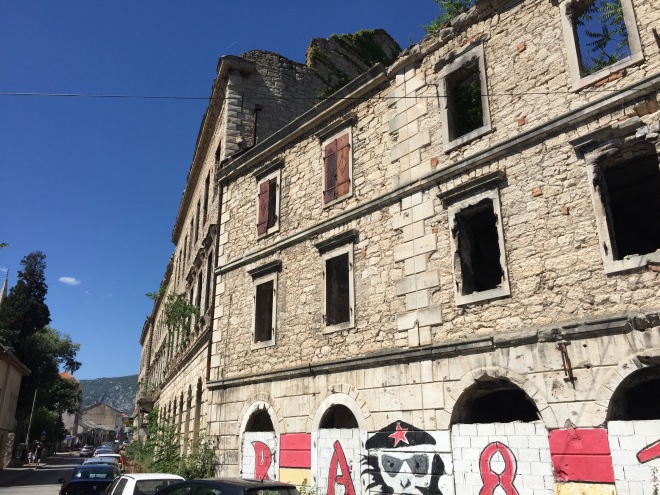
The owners have probably fled and may never return. Virtually all of Mostar’s Jews and Serbs are gone, but at what point does the government take over and demolish such a building? And who, if anyone, do they compensate for their loss? The wars of the 1990’s, like WWII, caused forced migration, not to mention genocidal murder as a tool of ethnic segregation. Former Bosnian Jews mostly went to Israel, at first temporarily, but most have remained there. Serbs mostly moved to a sector won when the 1995 Dayton treaty ending the Bosnian War. Mostar is a Croat/Bosniak city today.
The theme of my sabbatical has been “trees and rivers,” referring to two metaphorical ways that religion functions in human society. As a growing tree, religion gives us the opportunity to branch out toward the sun, sometimes by splitting from the main trunk. “Treeness” includes schisms and heresies as well as differentiation caused by enlightenment or progress. “Riverness” is the less-frequent way in which religion allows separate flows of human life to come together and unite. It includes syncretism, multiculturalisms, and what the Spanish call “convivencia,” or living together. Bosnia, for a time, was a religiously river-like place, with plenty of intermarriage between people of different faiths.
A third metaphor would have been too much for a sabbatical study, but “mountain” would be a good one. I’ve spoken and taught about how there are many paths to the top of the mountain of spiritual life, including in this talk a few years ago in Minneapolis. Religion can be seen as the human effort to move closer to the highest, the truest, the most beautiful, the most compassionate place in our world. Or in our hearts.
Above the lovely Buna river valley stand forested mountains, defining regions and dialects. Above Blagej, the small town where we camped, stands a great mountain with a fortress from the 1100’s. You can walk up on a switchback trail on the back side or you can climb up, frequently using all four limbs and helpful cables bolted into the rock. Jared took us up the hard way late one afternoon, and we thought how much our rock-climbing son and daughter-in-law would love it. Lynnell loved it. I liked it pretty well, but wish I was 30 pounds lighter! Here we are, coming down from a cave where Jared found some actual cave-people potsherds and we watched bats in the light of our headlamps.

We descended for maybe 20 minutes, and then Jared told us it was time to start climbing again. “Why?” I asked, and they both laughed. But I was serious! I wanted to just finish climbing down and be done by sunset, but there was A Fortress to see, and it was Up There. Over There. I sighed deeply and we climbed on.
Just before we got to the top, my Spidey Sense left me and I failed to notice a rock under some tall grass. I fell and came up with this goose-egg on my shin within ten seconds.

About twenty minutes later, as the sun was disappearing on the other side of the Buna Valley, we came upon the fortress. After that, we learned, we would take the nice, gradual, switchback trail for a couple miles back down to our campground. Whew!
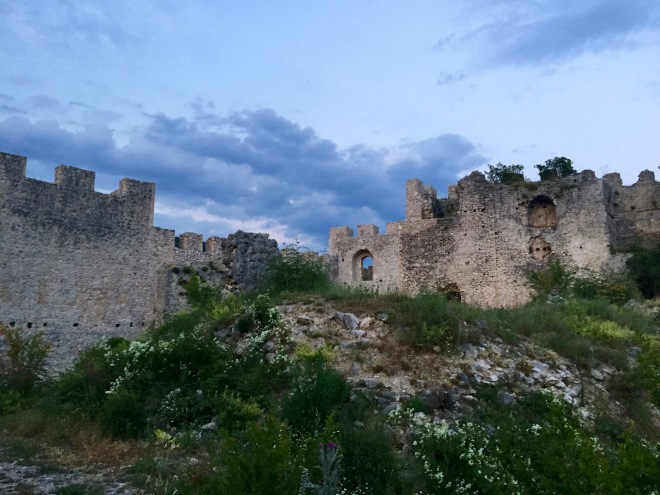
As we walked toward the fortress gate, an enormous BANG! sounded, and I was sure someone had detonated a bomb nearby. But Jared smiled, deservedly pleased with his timing.
You see, every day during the sacred month of Ramadan, someone fires a gunshot in every town, signaling that the fast was over. Muslims from Bosnia to Malaysia say a quick grace and reach for whatever is on the buffet! Jared knew quite well that the Iftar signal for his town would come from that Fortress just about when we got there.
Here’s a billboard advertising Iftar dinner at sunset

I’ll close with a greeting to my Muslim friends: may your fasting be a blessing to you and those you love. May you draw closer to God, who is simultaneously the mountaintop, the treetop, and the place where our rivers flow down to the sea.
As a country, the idea of Yugoslavia was not obvious. Even though most of the people in this corner of the Balkans spoke the same language and ate the same foods, there have always been greater forces working to split the “South Slavs” from each other. (Yugo, also spelled зуго, means south.) The centrifugal forces include waves of successive empires and the effects of all those mountain ranges separating, say, an Orthodox village from a Catholic one.
The people here were once subjects of the Roman Empire (Italy is just an eight-hour ferry ride across the Adriatic Sea). And the Byzantine Empire. And the Ottoman. And Austro-Hungarian. The western parts tend to be Roman Catholic, and the eastern parts Orthodox. And a bunch of utterly European Muslims, mostly in Bosnia.
But the idea of all these people having a free and diverse country pleases us Americans a lot. They weren’t going to be subjects of a foreign emperor or king, but instead would cooperate as fellow South Slavs in this beautiful and mountainous land. Besides, the so-called “nations” were all really similar. Of course, that didn’t make unifying other countries around here easy, either. Think of Germany and Italy, which after 150 years are still not convinced they are really unitary. So we set our aim at Yugoslavia, hoping to learn more about diversity
We ferried over from Bari, Italy, about ten days ago, and set up our van for four days of sun in Dubrovnik, on the coast of Croatia. Yugoslavia spent the nineties in an awful break-up, and the six former republics became independent states. Croatia is most famous for its coastline and islands. We loved the beach, rented an umbrella on two days, and just plain gaped at the gorgeous scenery.
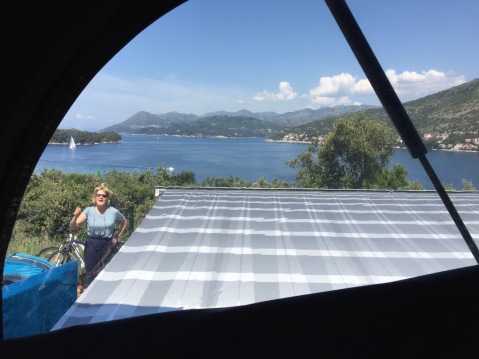
We also went into the old walled city, with its polished stone streets and perfect tile roofs, and walked along the ramparts. Unfortunately, we learned that the roofs were so new because Serbian fighters shelling the city from the mountainside above had burned or blasted all the old ones in 1991. The “Yugoslavian People’s Army,” basically were punishing Croatia for seceding from Yugoslavia.
We took a side trip to Montenegro (another of the six former Yugoslavian republics). We were greeted by a 60-minute line of cars at the border and were surprised to find out we had to buy car insurance for 18 Euros. We thought it was a scam, but the same thing was to happen a few days later entering Bosnia, and Lynnell recalled that many European car rentals do not allow you to enter those two very poor non-E.U. countries. Here’s the border crossing:

And here is the insurance office.

Rick Steves’ Guidebook advised us to drive around the fjord called the Bay of Kotor, and it was great advice. Huge forested mountains slope steeply into the water. Villages of houses that look like Monopoly game pieces cling to the shore. I had mussels for lunch that had been in the fjord a few hours before.
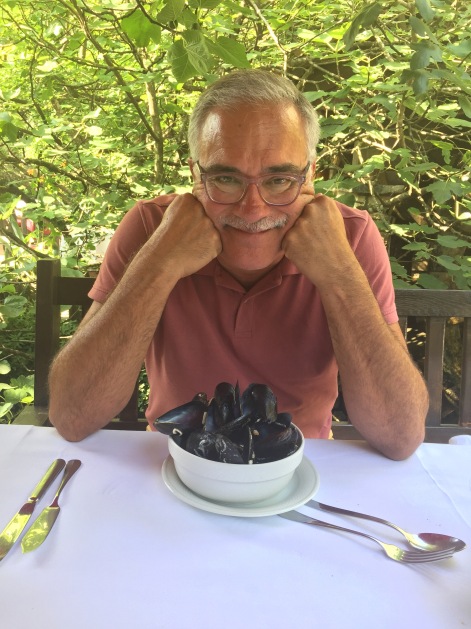
Lynnell ordered grilled fish, choosing from five actual just-caught fishes on a giant platter. We continued our drive and reached the Kotor Fortress in mid-afternoon. Much like Dubrovnik, Kotor is a red-roofed sanctuary from naval and land attacks. The walls are immense, and climb up the mountainside maybe a half-mile to a lookout and artillery post on the top. We took this photo from a little chapel halfway to the top (and then turned back!). The modern city lies outside the walls along the bay.

After the wars in the 1990’s, at least one of the new countries, Bosnia and Herzegovina, resisted the insane nationalistic fervor that drove Serbians and Croats to atrocities, ethnic cleansing, mass deportations, and state-sanctioned acts of terror I will not name here. B & H had been, and to some extent still is, a multicultural place. You see minarets and steeples in the same village. And even the road signs, unlike in the other former Yugoslav Republics, are multi-language. Or more accurately, multi-alphabet. Serbs and Croats are always finding ways to diverge, and during the 1800’s, a Serbian invented a cyrillic alphabet which is now the official alphabet of Serbia. People are free to call their restaurant a ресторан or a restoran. On road signs, the government spells town names both ways: мостар is Mostar, and сарајево is Sarajevo. But sometimes, vandals who disapprove make changes:

Even calling the language everyone speaks “Serbo-Croatian” is sort of like “Scottish-English” or “Americo-Canadian.” It’s the same language, with small variations, but the Orthodox people call themselves Serbs (сербс). Catholic people call themselves Croatians. It’s one of the only examples in the world of people being able to use two different alphabets. According to Wikipedia, 47% of the 8 million or so Serbians in the former Yugoslavia prefer the Latin alphabet, and 36% prefer the цзриллиц.
OK, a couple more pictures before I sign off. The internet here is spotty and it’s been too long between posts! Here’s the Bosnian guy at the border selling us insurance for his country. He used a manual portable typewriter and carbon paper. It’s a really poor country.

But we found him and his fellow Bosnians helpful, even if we had to use sign language and google translate sometimes. Below, Lynnell asks where we can find a B-H Telecom store where we could buy SIM cards for our precious phones.

That’s all for now. In our next post, we’ll have more about the geographic beauty and human tragedy of this former country, a cautionary tale about the dangers of religion, patriotism, and nationalism.
Photos from our time in Jerusalem / Haifa / Istanbul / Rome / Sorrento / Naples / Pompeii / Tuscan Hills / Elba / Rome / Vegas / Zion National Park.
Hover your cursor over each image to see the caption.
I guess whichever country we decided to spend the month of May in was bound to be beautiful.
We spent Halloween in Zaragoza, 41 degrees north latitude, and the aspens and poplars were all bright yellow. By January in Merzouga, in the Sahara desert of southern Morocco, the last yellow leaves were dropping in the sunshine, 31 degrees north latitude, and it was COLD at night.
So here we are in Italy, where whole hillsides are bursting with yellow wildflowers and hedges smell like flower shops. We are soaking in the beauty and sunshine, and we really do wish you were here. I’d love to be making you all coffee and urging you to have another croissant from the campground bakery. Honestly, it’s no trouble: we’ll just bike over there.

We spent last week based at a campground in the middle of Tuscany, exploring towns and savoring some of the greatest art we have ever seen. For example, in Florence, from the church of Santa Maria Novella, a series of frescoes on the life of Mary, including her engagement to Joseph and her earlier move from her family home to the Jerusalem Temple, which the Qur’an describes but the Canonical Gospels do not:

And this immense painted crucifix by Giotto that hangs over the nave:

Or this one, moved from the famous Duomo church to the Museum across the street. It’s part of a series of carved hexagons, and it shows Eve being taken out of the side of Adam, the mythic story from Genesis about the one time a woman was born from a man, who slept through it all. Of course.

Beauty is not mostly made by humans, even if we’re the ones who notice it. The sun’s path across the sky can be traced and marveled at. This brass line on the floor of the nave notes the constellations of the zodiac which rule each month of our year. This medallion celebrates the winter solstice, when the sun casts its longest reach of the year through the door of the Basilica.

We also loved the decoration inside the Great Synagogue of Florence, the Tempio Maggiore. It reminds you of the Muslim world, and it should, since after Jews were expelled from Catholic Spain, they were welcomed in Muslim places like Morocco, Egypt, and Turkey, and the architecture of those lands inspired the men who built this great sanctuary in the 1880’s. The brass plate marks the pew for the Consiglio, the advisory board of the synagogue.

We’ve also enjoyed the Italians’ flexible relationship with rules and regulations, and their love for everything amore. Lovers write their initials on these padlocks, attach them to the wrought iron of this bridge in Florence, and then throw the key in the river. They are not allowed to do this, says the attractive bronze sign. I am sure a municipal employee polishes it a couple of times a year.

After a week of love, art, and walking our bikes when the uphills got too long, we left Tuscany.
Now, we’re on the island of Elba, best known for Napoleon being exiled here in 1814 after his disastrous campaign in Russia. He attacked Russia because he feared they were conspiring with the English to attack his Empire. So pretty much all the European powers got together and sent him here, where he immediately had marshes drained, roads built, water supplies set up, and hospitals constructed. After 300 days, he got bored with Elba, sneaked away, landed in France a few days later by boat, and marched to Paris to take up his throne again. He was defeated about a hundred days later at Waterloo, in Belgium, and exiled this time to the other side of the planet, a South Atlantic island named St. Helena.
Here’s a view of Elba, where our ferry dropped us off at the dock in Portoferraia.

We easily found our campground on the south side of the island, and settled in for a week of biking, swimming in the sea, hiking, and reading.
We have novels and nonfiction, but the news from home is gripping. God help us. Despite all the claims of news being faked (and surely some of the news we read now, and read before the election WAS fake), it looks like we are finally getting stories that so many wanted kept “in the family.”
So I’ll close with one of my favorite paintings by Botticelli in the Uffizi Gallery. It shows the mythic King Midas, advised by Suspicion and Ignorance, sitting on his throne. He’s getting ready to judge the victim of slander, who’s being dragged by the hair by Defamation, accompanied by Fraud, Spite, and Deception. On the left, Repentance looks at the naked Truth, who raises her eyes to heaven.

First of all, thanks to all our well-wishers since our break-in a week ago. We keep discovering little things that we want to use that are gone, and get angry again. This morning (Monday), the VW dealer is installing the four parts of the door handle which the thieves wrecked in order to get into the van.
But we are back to our happy routine of van life, and it is so great to be cooking for ourselves again.
Here’s one last theft-related photo: we googled “Apple Computer Dealers” and found one called the R-Store a few miles away. We took the subway and started following the blue dotted line on Lynnell’s phone. But the store was not there! About ten seconds before she took this picture, I confidently pronounced that the store must have moved, because there was no such place as #1 Whatever Street. The facial expression is a re-enactment, but I promise I only moved maybe five feet for the picture.

A few days later, after careful application of sunscreen, and parking the van in a VERY SAFE SPOT, we spent four hours in the remarkably well-preserved Roman city of Pompeii. It’s laid out on a grid, and 20,000 people lived there, although on August 24, the day Mount Vesuvius blew its top in CE 79, a lot of folks had evacuated. After digging two meters of soil away, the wooden roofs were gone, but the walls, doors, windows, and floors were intact.
You could easily imagine someone ducking out this back door to go buy something for dinner.

And like a lot of city dwellers today, Pompeiians apparently bought, rather than cooked, most of their meals. Here’s what Tour Guide author Rick Steves calls “a fast food place” that opens right onto the street:

My sister, who in addition to being much younger than I am, arrived here long, long ago, sent me this picture after the blog post was published:

Pompeii was part of a network of multicultural cities and towns linked by the Globalization of the day, the Pax Romana. Rome conquered, taxed, regulated, and pretty much made sure that the nations they ruled stayed peaceful for trade and travel. Here was the deal Rome made: “Go ahead and have your own religions and foods. Speak your languages. But don’t try to separate yourself from the Empire. You can sell your goods all over the world, and be able to buy things from far away. We’re going to build a lot of roads (you’re welcome); aqueducts and canals (you’re welcome); and Temples (make sure you worship Caesar as well as whoever else you’ve got). No walls on your borders unless we build them. Be ready to send some young men to the other side of the world to fight barbarians. That’s the deal.”
Young men could also make a name for themselves–and a lot of money if they were successful–in pro sports. Gladiators lived in the cells around this huge training ground in Pompeii, and fought one another in the arena behind. The modern Polish sculptor Igor Mitoraj made these great cast bronze pieces to commemorate them.
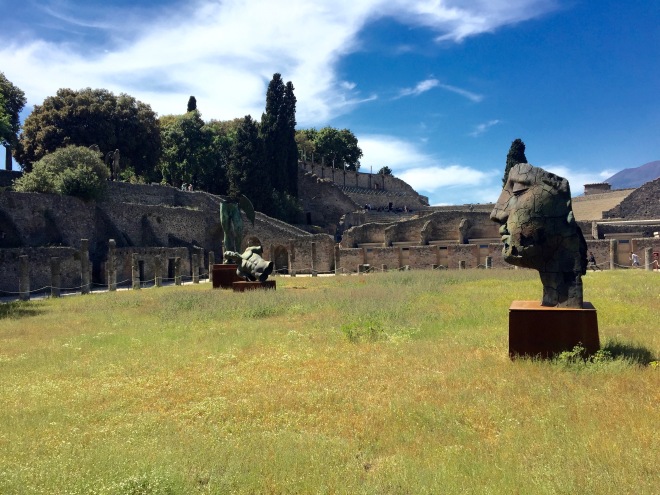
And then, after the volcano spread the horrible cloud of death and concealment, Pompeii was gone. The people passed into anonymity, and their carefully-built city was gone. Life is short, wrote the French poet H.-F. Amiel, and we do not have much time to gladden the hearts of those who travel with us along the way. Be quick to love. Make haste to be kind. And the God of compassion will go with you.
Back in Rome, we ran into some brass cobblestones every once in awhile. We would squat and read about the mostly Jewish people who had once lived in the houses we passed. It was awfully sobering. All the people named on these stones were arrested, mostly on March 21, 1944. So close to the end of the war! By May, all had been killed, mostly in Auschwitz, far to the north and east, though a few of them did not even get that far. The DiConsiglio family lived here. Some were hiding at their grandfather’s hardware store across the street. The German artist Günter Demnig has installed these and other Stumbling Stones, as he calls them, in Rome and elsewhere in Europe.

Jews first came here in 161 BCE, and their religion was admired throughout the Empire. Unlike the violent, “degraded, and shameful practices” of the Romans (Tacitus, Annals), Jews had high ethical standards and a God whose name was too holy even to pronounce. Plenty of “pagan” Romans converted to Judaism during that time. The Jewish community flourished here in the Middle Ages, and scholars helped translate Arabic and Greek works into Latin. There was a famous Talmud school. When the Jews of Spain were expelled in 1492, many came here, with no money, and were welcomed. In other parts of Italy, they were turned away. By 1555, however, the Pope ordered Jews into a ghetto, and forced them to wear yellow badges. For the next three hundred years, there were more tolerant popes and less tolerant ones, and life for Jews in Rome could be comfortable and then suddenly precarious. Besides being unwilling to convert to the state religion, Jews were also targets of suspicion because they were cosmopolitan, educated, and rootless. Their rootlessness, of course, was the result of their having often had to relocate from whatever place they’d try to put down roots in.
80% of Italian Jews survived the Holocaust, mostly by hiding or emigrating, and some by having the good luck to be put in Italian internment camps, which often did not allow inmates to be shipped to the death camps.
The Jewish community in Rome today numbers about 25,000, according to a recent Ha’aretz article. Wikipedia says 45,000. There are about fourteen synagogues in the city, though some are barely functional.
Not far from the DiConsiglio’s home are the ruins of the Colosseum where the Romans used to watch prisoners thrown to the lions, gladiators fighting to the death, and even mock naval battles. They could put six feet of water in the place in short order. It was sobering to read the placards describing how some combatants were ignited to add drama to the spectacle, and how Jewish and other slaves were put to work constructing the Colosseum. Apparently a lot of the funds used to quarry and transport stone came from selling valuable objects stolen in the sack of Jerusalem in 70 CE.

The bronze Stumbling Stones help us remember. Maybe my favorite work of Roman art, though, was this statue (below) of a wayfaring stranger. We saw it at a distance, and couldn’t help going up to see if there was a face under the hood. Sure enough, there was, as well as wounds in feet and hands. The inscription on the wall plaque comes from Jesus’ famous story about how people would be judged when, one day, they meet their Maker. I was a stranger, and you took me in.

The Final Exam in Life, according to Jesus is: when you cared for ones who the world regards as unimportant, you were caring for me. If they were sick, imprisoned, homeless, or lacking food or clothing, the way you treated them will reveal your spiritual quality. How you treat your friends and family is important, sure, but the real test is something else. Your faith in God is revealed in how you act toward people who aren’t going to repay you or make you famous or rich.
St. Francis put it another way: Preach the Gospel. If necessary, use words.
Five days ago, unknown jerks broke the door handle off our van and got in, grabbed all the luggage they could find, and drove off. We had been parked in the lot of a big mall near the airport, getting Italian SIM cards for our phones. It took longer than usual for the SIM cards to activate, and we went back to the van to get a couple things, talking about the weird message Lynnell had gotten about two purchases in Rome on her credit card. We thought the mall wifi was hacked, but when we got to the car, we found out WE had been hacked. Jacked. Fracked. Here’s where we had been parked. Yeah, you’re right: the tree on the left covered the bad guys. They just grabbed everything that was packed like luggage, which was pretty much all our stuff, minus the cooking gear and travel books.

I won’t bore you with the list of stuff we will never see again, but the police were very calm. No, we can’t give you a form right now, but don’t worry, they told us, you can file your report any time in the next 90 days. Don’t feel too bad, that mall doesn’t have very good security. Go have a nice dinner with your family. It was closing time, maybe 6:30 pm, and the officers were all going home. Thanks, guys.
We were stunned and numb, walking aimlessly back to the mall and trying to decide what to do after visiting the precinct. We were out by the airport, planning on putting the van in long-term parking and meeting our son Carter and daughter-in-law Jennifer who were joining us within the hour for a long weekend, getting away to Rome from rainy, cold London. For a while, we thought it would be better to stay in a hotel near the airport, so we could have the van to drive to big box stores and buy new stuff. We needed everything.
But we wisely decided to leave the van in a much more secure lot, near the po-po, and go meet Jen & Carter’s flight.
The next 24 hours we spent in their loving and efficient care, making lists, telling the story over and over, going through Kübler-Ross’ stages of loss:
My “precious laptop” had been backed up pretty often to the “Cloud,” thanks to Breck’s google-doc system, but some documents and many photos from the last eight months are now just plain gone. (Yes, we had also backed our computers up to a hard drive, but alas, the thieves got the hard drive too–it was packed away in our luggage.) The best photos have been saved here, on this blog, which lives in the Cloud, too. Meanwhile, our son Jackson, who was robbed four years ago in Minneapolis, helped me remotely lock my computer, and walked me through creating backup systems I should have had in place before now. He is a gem. Here he is with our soon-to-be-daughter-in-law, Mackenzie:

And Lynnell and I are both fine. Uninjured. It’s just stuff and arrangements. Lynnell said she had double-trauma: first, getting all her belongings stolen; then realizing she would have to go shopping, something she hates. But Jennifer, who is shopping-savvy and highly-organized, shepherded her through two big-box stores, Decathalon and H&M. and they managed to buy just about everything she needed (plus more!) in less than three hours.
Yesterday, we went to see an English-speaking doctor who wrote new prescriptions for the medications we had been carrying. The appointment cost us $50, and the Rx were filled down the street in ten minutes for one-fourth the cost of what it would be in the USA. We said goodbye to Carter and Jennifer, and I found a Big and Tall store with great stuff, and then bought some wedding bowties made in the back room of the shop.
Other than being shellshocked, really, we have had a great time. The “kids” were so utterly sane and adult, so adept at finding amazing restaurants and patiently waiting in line for them (and it was worth it, just to savor the pasta). They also love walking, and this is a great city for it. We saw the Pope on Sunday, at St. Peter’s, in his white Popemobile, waving and encouraging the faithful to work for justice in the world and nurture their inner lives so they wouldn’t burn out. Good advice for us, too. We saw the Colosseum, which is bigger than I could have imagined, and its history is so gruesome. We spent a long time in the Pantheon, which has been perfectly preserved for 1800+ years, and couldn’t get enough of that shaft of sunlight coming in through the circular opening at the top of the dome.

We took a slow walking tour of the ruins of the Roman Forum, and sat in the sun while the “kids” bought a very cool gift for someone back home who might be reading this. We will be eternally grateful to these two for parenting us through our ordeal.

We will get around to writing about our four days in Istanbul. Lynnell is giving me her laptop every morning, and I will find pictures from wikimedia to replace my stolen ones, and will properly cite my usage. We might write about our two days in Figueres, Spain, where we learned that Salvador Dalí was an amazing artist and despicable human being. Figueres was where we waited for our van to be ready at the VW dealer, after having flown from Istanbul to Barcelona to resume VanLife.
But Rome is a wonderful city, loud and full of tourists following guides, and full of monuments to the vanity of men who built maybe the greatest empire ever by systematically stealing from others and then building infrastructure that lasts for ages.

This is Nero: a paranoic, thief, bigot, liar, and very cruel, humorless man. The pigeon and the graffito “Hi” made me smile.